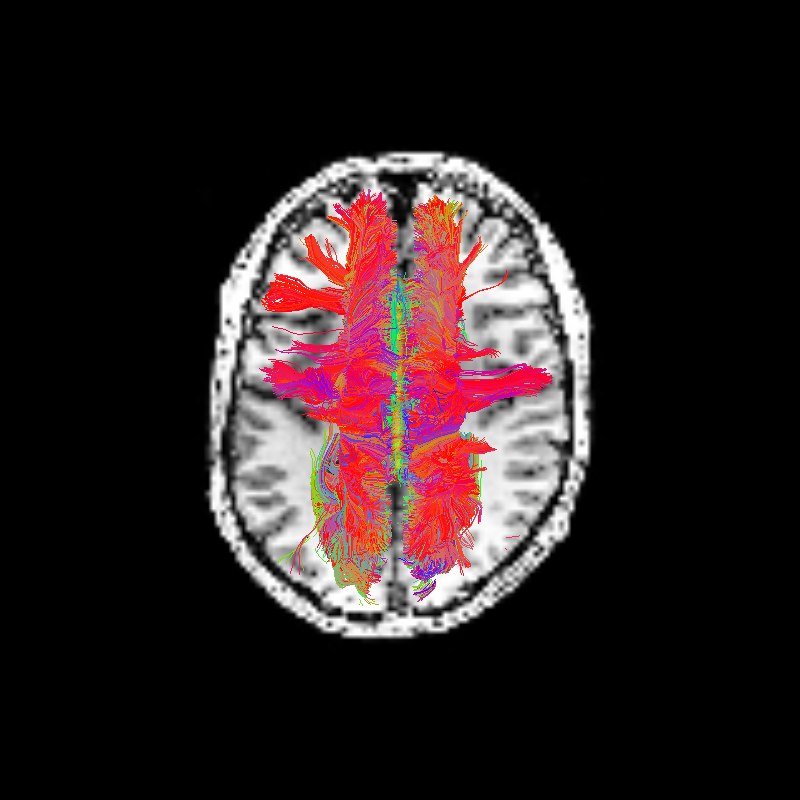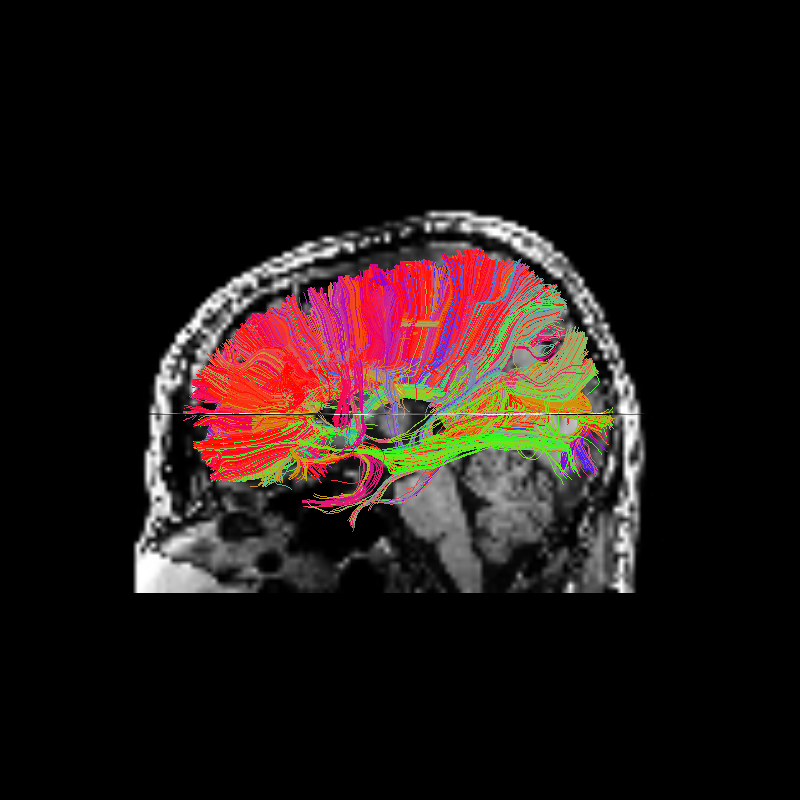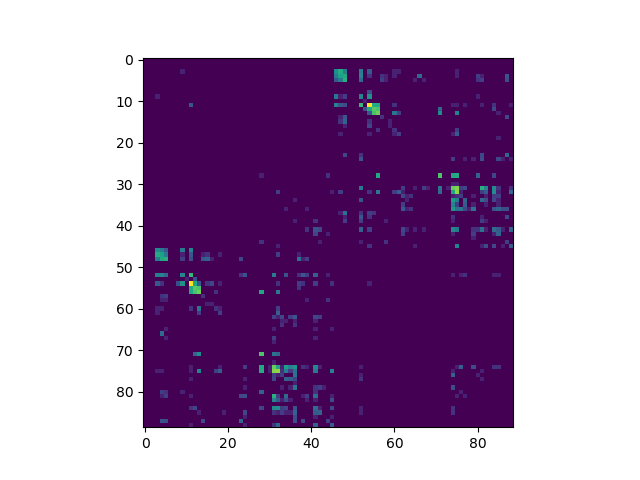Connectivity Matrices, ROI Intersections and Density Maps¶
This example is meant to be an introduction to some of the streamline tools
available in DIPY. Some of the functions covered in this example are
target, connectivity_matrix and density_map. target allows one
to filter streamlines that either pass through or do not pass through some
region of the brain, connectivity_matrix groups and counts streamlines
based on where in the brain they begin and end, and finally, density map counts
the number of streamlines that pass though every voxel of some image.
To get started we’ll need to have a set of streamlines to work with. We’ll use EuDX along with the CsaOdfModel to make some streamlines. Let’s import the modules and download the data we’ll be using.
import numpy as np
from scipy.ndimage.morphology import binary_dilation
from dipy.data import read_stanford_labels, read_stanford_t1
from dipy.direction import peaks
from dipy.reconst import shm
from dipy.tracking import utils
from dipy.tracking.local_tracking import LocalTracking
from dipy.tracking.stopping_criterion import BinaryStoppingCriterion
from dipy.tracking.streamline import Streamlines
hardi_img, gtab, labels_img = read_stanford_labels()
data = hardi_img.get_data()
labels = labels_img.get_data()
t1 = read_stanford_t1()
t1_data = t1.get_data()
We’ve loaded an image called labels_img which is a map of tissue types such
that every integer value in the array labels represents an anatomical
structure or tissue type 1. For this example, the image was created so that
white matter voxels have values of either 1 or 2. We’ll use
peaks_from_model to apply the CsaOdfModel to each white matter voxel
and estimate fiber orientations which we can use for tracking. We will also
dilate this mask by 1 voxel to ensure streamlines reach the grey matter.
white_matter = binary_dilation((labels == 1) | (labels == 2))
csamodel = shm.CsaOdfModel(gtab, 6)
csapeaks = peaks.peaks_from_model(model=csamodel,
data=data,
sphere=peaks.default_sphere,
relative_peak_threshold=.8,
min_separation_angle=45,
mask=white_matter)
Now we can use EuDX to track all of the white matter. To keep things reasonably
fast we use density=1 which will result in 1 seeds per voxel. The stopping
criterion, determining when the tracking stops, is set to stop when the
tracking exit the white matter.
affine = np.eye(4)
seeds = utils.seeds_from_mask(white_matter, affine, density=1)
stopping_criterion = BinaryStoppingCriterion(white_matter)
streamline_generator = LocalTracking(csapeaks, stopping_criterion, seeds,
affine=affine, step_size=0.5)
streamlines = Streamlines(streamline_generator)
The first of the tracking utilities we’ll cover here is target. This
function takes a set of streamlines and a region of interest (ROI) and returns
only those streamlines that pass though the ROI. The ROI should be an array
such that the voxels that belong to the ROI are True and all other voxels
are False (this type of binary array is sometimes called a mask). This
function can also exclude all the streamlines that pass though an ROI by
setting the include flag to False. In this example we’ll target the
streamlines of the corpus callosum. Our labels array has a sagittal slice
of the corpus callosum identified by the label value 2. We’ll create an ROI
mask from that label and create two sets of streamlines, those that intersect
with the ROI and those that don’t.
cc_slice = labels == 2
cc_streamlines = utils.target(streamlines, affine, cc_slice)
cc_streamlines = Streamlines(cc_streamlines)
other_streamlines = utils.target(streamlines, affine, cc_slice,
include=False)
other_streamlines = Streamlines(other_streamlines)
assert len(other_streamlines) + len(cc_streamlines) == len(streamlines)
We can use some of DIPY’s visualization tools to display the ROI we targeted above and all the streamlines that pass though that ROI. The ROI is the yellow region near the center of the axial image.
from dipy.viz import window, actor, colormap as cmap
# Enables/disables interactive visualization
interactive = False
# Make display objects
color = cmap.line_colors(cc_streamlines)
cc_streamlines_actor = actor.line(cc_streamlines,
cmap.line_colors(cc_streamlines))
cc_ROI_actor = actor.contour_from_roi(cc_slice, color=(1., 1., 0.),
opacity=0.5)
vol_actor = actor.slicer(t1_data)
vol_actor.display(x=40)
vol_actor2 = vol_actor.copy()
vol_actor2.display(z=35)
# Add display objects to canvas
r = window.Renderer()
r.add(vol_actor)
r.add(vol_actor2)
r.add(cc_streamlines_actor)
r.add(cc_ROI_actor)
# Save figures
window.record(r, n_frames=1, out_path='corpuscallosum_axial.png',
size=(800, 800))
if interactive:
window.show(r)
r.set_camera(position=[-1, 0, 0], focal_point=[0, 0, 0], view_up=[0, 0, 1])
window.record(r, n_frames=1, out_path='corpuscallosum_sagittal.png',
size=(800, 800))
if interactive:
window.show(r)

Corpus Callosum Axial¶

Corpus Callosum Sagittal¶
Once we’ve targeted on the corpus callosum ROI, we might want to find out which
regions of the brain are connected by these streamlines. To do this we can use
the connectivity_matrix function. This function takes a set of streamlines
and an array of labels as arguments. It returns the number of streamlines that
start and end at each pair of labels and it can return the streamlines grouped
by their endpoints. Notice that this function only considers the endpoints of
each streamline.
M, grouping = utils.connectivity_matrix(cc_streamlines, affine, labels,
return_mapping=True,
mapping_as_streamlines=True)
M[:3, :] = 0
M[:, :3] = 0
We’ve set return_mapping and mapping_as_streamlines to True so that
connectivity_matrix returns all the streamlines in cc_streamlines
grouped by their endpoint.
Because we’re typically only interested in connections between gray matter regions, and because the label 0 represents background and the labels 1 and 2 represent white matter, we discard the first three rows and columns of the connectivity matrix.
We can now display this matrix using matplotlib, we display it using a log scale to make small values in the matrix easier to see.
import numpy as np
import matplotlib.pyplot as plt
plt.imshow(np.log1p(M), interpolation='nearest')
plt.savefig("connectivity.png")

Connectivity of Corpus Callosum¶
In our example track there are more streamlines connecting regions 11 and 54 than any other pair of regions. These labels represent the left and right superior frontal gyrus respectively. These two regions are large, close together, have lots of corpus callosum fibers and are easy to track so this result should not be a surprise to anyone.
However, the interpretation of streamline counts can be tricky. The relationship between the underlying biology and the streamline counts will depend on several factors, including how the tracking was done, and the correct way to interpret these kinds of connectivity matrices is still an open question in the diffusion imaging literature.
The next function we’ll demonstrate is density_map. This function allows
one to represent the spatial distribution of a track by counting the density of
streamlines in each voxel. For example, let’s take the track connecting the
left and right superior frontal gyrus.
lr_superiorfrontal_track = grouping[11, 54]
shape = labels.shape
dm = utils.density_map(lr_superiorfrontal_track, affine, shape)
Let’s save this density map and the streamlines so that they can be visualized together. In order to save the streamlines in a “.trk” file we’ll need to move them to “trackvis space”, or the representation of streamlines specified by the trackvis Track File format.
To do that, we will use tools available in nibabel)
import nibabel as nib
from dipy.io.stateful_tractogram import Space, StatefulTractogram
from dipy.io.streamline import save_trk
# Save density map
dm_img = nib.Nifti1Image(dm.astype("int16"), hardi_img.affine)
dm_img.to_filename("lr-superiorfrontal-dm.nii.gz")
lr_sf_trk = Streamlines(lr_superiorfrontal_track)
# Save streamlines
sft = StatefulTractogram(lr_sf_trk, dm_img, Space.VOX)
save_trk(sft, "lr-superiorfrontal.trk")
Footnotes
- 1
The image aparc-reduced.nii.gz, which we load as
labels_img, is a modified version of label map aparc+aseg.mgz created by FreeSurfer. The corpus callosum region is a combination of the FreeSurfer labels 251-255. The remaining FreeSurfer labels were re-mapped and reduced so that they lie between 0 and 88. To see the FreeSurfer region, label and name, represented by each value see label_info.txt in ~/.dipy/stanford_hardi.- 2
An affine transformation is a mapping between two coordinate systems that can represent scaling, rotation, sheer, translation and reflection. Affine transformations are often represented using a 4x4 matrix where the last row of the matrix is
[0, 0, 0, 1].
Example source code
You can download the full source code of this example. This same script is also included in the dipy source distribution under the doc/examples/ directory.
